Relative and Combined Impacts of Climate and Land Use/Cover Change for the Streamflow Variability in the Baro River Basin (BRB)
Abstract
:1. Introduction
2. Materials and Methods
2.1. Study Area
2.2. Methods
2.2.1. Datasets
Observed Hydro-Meteorological Data
Geospatial Maps Data
2.2.2. Hydrological Modeling Using SWAT+
2.2.3. SWAT+ Model Performance Assessment
2.3. Design Scenarios
2.3.1. Land Use/Cover Change Scenarios
2.3.2. Climate Change Scenarios
2.3.3. Relative and Combined Contribution Rate of LULC and CC on Streamflow
3. Results
3.1. Land Use/Cover Change Analysis
3.2. Climate Change Analysis
3.3. Hydrological Modeling Using SWAT+
3.4. Streamflow Response Modeling under Different Scenarios
3.4.1. Scenario 1: Constant LULC with Varying Climate Scenarios
3.4.2. Scenario 2: Constant Climate but Varying LULCC
3.4.3. Scenario 3: Streamflow Response to Relative and Combined Impact of CC and LULCC
4. Discussion
5. Conclusions
Author Contributions
Funding
Institutional Review Board Statement
Institutional Consent Statement
Data Availability Statement
Acknowledgments
Conflicts of Interest
References
- Kayitesi, N.M.; Guzha, A.C.; Mariethoz, G. Impacts of Land Use Land Cover Change and Climate Change on River Hydro-Morphology-a Review of Research Studies in Tropical Regions. J. Hydrol. 2022, 615, 128702. [Google Scholar] [CrossRef]
- Kassaye, S.M.; Tadesse, T.; Tegegne, G.; Hordofa, A.T. Quantifying the Climate Change Impacts on the Magnitude and Timing of Hydrological Extremes in the Baro River Basin, Ethiopia. Environ. Syst. Res. 2024, 13, 2. [Google Scholar] [CrossRef]
- Hung, C.-L.J.; James, L.A.; Carbone, G.J.; Williams, J.M. Impacts of Combined Land-Use and Climate Change on Streamflow in Two Nested Catchments in the Southeastern United States. Ecol. Eng. 2020, 143, 105665. [Google Scholar] [CrossRef]
- Shrestha, S.; Bhatta, B.; Shrestha, M.; Shrestha, P.K. Integrated Assessment of the Climate and Landuse Change Impact on Hydrology and Water Quality in the Songkhram River Basin, Thailand. Sci. Total Environ. 2018, 643, 1610–1622. [Google Scholar] [CrossRef] [PubMed]
- Iqbal, M.; Wen, J.; Masood, M.; Masood, M.U.; Adnan, M. Impacts of Climate and Land-Use Changes on Hydrological Processes of the Source Region of Yellow River, China. Sustainability 2022, 14, 14908. [Google Scholar] [CrossRef]
- Cao, C.; Sun, R.; Wu, Z.; Chen, B.; Yang, C.; Li, Q.; Fraedrich, K. Streamflow Response to Climate and Land-Use Changes in a Tropical Island Basin. Sustainability 2023, 15, 13941. [Google Scholar] [CrossRef]
- Sharma, S.K.; Sinha, R.K.; Eldho, T.I.; Patel, H.M. Individual and Combined Impacts of Land Use/Cover and Climate Change on Water Balance Components of a Tropical River Basin. Environ. Model. Assess. 2023, 29, 67–90. [Google Scholar] [CrossRef]
- Kundu, S.; Khare, D.; Mondal, A. Individual and Combined Impacts of Future Climate and Land Use Changes on the Water Balance. Ecol. Eng. 2017, 105, 42–57. [Google Scholar] [CrossRef]
- Wang, S.; Zhang, Z.; McVicar, T.R.; Guo, J.; Tang, Y.; Yao, A. Isolating the Impacts of Climate Change and Land Use Change on Decadal Streamflow Variation: Assessing Three Complementary Approaches. J. Hydrol. 2013, 507, 63–74. [Google Scholar] [CrossRef]
- Ayalew, A.D.; Wagner, P.D.; Tigabu, T.B.; Sahlu, D.; Fohrer, N. Hydrological Responses to Land Use and Land Cover Change and Climate Dynamics in the Rift Valley Lakes Basin, Ethiopia. J. Water Clim. Change 2023, 14, 2788–2807. [Google Scholar] [CrossRef]
- Guo, Y.; Fang, G.; Xu, Y.-P.; Tian, X.; Xie, J. Identifying How Future Climate and Land Use/Cover Changes Impact Streamflow in Xinanjiang Basin, East China. Sci. Total Environ. 2020, 710, 136275. [Google Scholar] [CrossRef]
- Mohseni, U.; Agnihotri, P.G.; Pande, C.B.; Durin, B. Understanding the Climate Change and Land Use Impact on Streamflow in the Present and Future under CMIP6 Climate Scenarios for the Parvara Mula Basin, India. Water 2023, 15, 1753. [Google Scholar] [CrossRef]
- Kiprotich, P.; Wei, X.; Zhang, Z.; Ngigi, T.; Qiu, F.; Wang, L. Assessing the Impact of Land Use and Climate Change on Surface Runoff Response Using Gridded Observations and Swat+. Hydrology 2021, 8, 48. [Google Scholar] [CrossRef]
- Li, Z.; Liu, W.Z.; Zhang, X.C.; Zheng, F.L. Impacts of Land Use Change and Climate Variability on Hydrology in an Agricultural Catchment on the Loess Plateau of China. J. Hydrol. 2009, 377, 35–42. [Google Scholar] [CrossRef]
- Wedajo, G.K.; Muleta, M.K.; Awoke, B.G. Impacts of Combined and Separate Land Cover and Climate Changes on Hydrologic Responses of Dhidhessa River Basin, Ethiopia. Int. J. River Basin Manag. 2021, 22, 57–70. [Google Scholar] [CrossRef]
- Mekonnen, D.F.; Duan, Z.; Rientjes, T.; Disse, M. Analysis of Combined and Isolated Effects of Land-Use and Land-Cover Changes and Climate Change on the Upper Blue Nile River Basin’s Streamflow. Hydrol. Earth Syst. Sci. 2018, 22, 6187–6207. [Google Scholar] [CrossRef]
- Liu, Z.; Cuo, L.; Li, Q.; Liu, X.; Ma, X.; Liang, L.; Ding, J. Impacts of Climate Change and Land Use/Cover Change on Streamflow in Beichuan River Basin in Qinghai Province, China. Water 2020, 12, 1198. [Google Scholar] [CrossRef]
- Nie, N.; Zhang, W.; Liu, M.; Chen, H.; Zhao, D. Separating the Impacts of Climate Variability, Land-Use Change and Large Reservoir Operations on Streamflow in the Yangtze River Basin, China, Using a Hydrological Modeling Approach. Int. J. Digit. Earth 2021, 14, 231–249. [Google Scholar] [CrossRef]
- Tesfaw, B.A.; Dzwairo, B.; Sahlu, D. Assessments of the Impacts of Land Use/Land Cover Change on Water Resources: Tana Sub-Basin, Ethiopia. J. Water Clim. Change 2023, 14, 421–441. [Google Scholar] [CrossRef]
- Tenagashaw, D.Y.; Muluneh, M.; Metaferia, G.; Mekonnen, Y.A. Land Use and Climate Change Impacts on Streamflow Using SWAT Model, Middle Awash Sub Basin, Ethiopia. Water Conserv. Sci. Eng. 2022, 7, 183–196. [Google Scholar] [CrossRef]
- Assfaw, M.T.; Neka, B.G.; Ayele, E.G. Modeling the Impact of Climate Change on Streamflow Responses in the Kessem Watershed, Middle Awash Sub-Basin, Ethiopia. J. Water Clim. Change 2023, 14, 4837–4859. [Google Scholar] [CrossRef]
- Woube, M. Flooding and Sustainable Land-Water Management in the Lower Baro-Akobo River Basin, Ethiopia. Appl. Geogr. 1999, 19, 235–251. [Google Scholar] [CrossRef]
- Mengistu, A.G.; Woldesenbet, T.A.; Dile, Y.T.; Bayabil, H.K.; Tefera, G.W. Modeling Impacts of Projected Land Use and Climate Changes on the Water Balance in the Baro Basin, Ethiopia. Heliyon 2023, 9, e13965. [Google Scholar] [CrossRef] [PubMed]
- Kassaye, S.M.; Tadesse, T.; Tegegne, G.; Tadesse, K.E. The Sensitivity of Meteorological Dynamics to the Variability in Catchment Characteristics. Water 2022, 14, 3776. [Google Scholar] [CrossRef]
- Terefe, B.; Dibaba, W.T. Corrected Proof Evaluation of Historical CMIP6 Model Simulations and Future Climate Change Projections in the Baro River Basin. J. Water Clim. Change 2023, 14, 2680–2705. [Google Scholar] [CrossRef]
- Muleta, T.N. Climate Change Scenario Analysis for Baro-Akobo River Basin, Southwestern Ethiopia. Environ. Syst. Res. 2021, 10, 24. [Google Scholar] [CrossRef]
- Moges, S.A.; Taye, M.T. Regional Flood Frequency Curves for Remote Rural Areas of the Nile River Basin: The Case of Baro-Akobo Drainage Basin, Ethiopia; Elsevier Inc.: Amsterdam, The Netherlands, 2019; ISBN 9780128159989. [Google Scholar]
- Kassaye, S.M.; Tadesse, T.; Tegegne, G.; Hordofa, A.T. Integrated Impact of Land Use/Cover and Topography on Hydrological Extremes in the Baro River Basin. Environ. Earth Sci. 2024, 83, 49. [Google Scholar] [CrossRef]
- Tilahun, A.K.; Haregeweyn, N.; Pingale, S.M. Landscape Changes and Its Consequences on Soil Erosion in Baro River Basin, Ethiopia. Model. Earth Syst. Environ. 2018, 4, 793–803. [Google Scholar] [CrossRef]
- Yirgu, T.; Yihunie, Y.; Assele, A.; Wogayehu, T. Land Use/Land Cover Dynamics and Its Environmental Impacts in Kulfo Watershed, Gamo Highlands, South Western Ethiopia. J. Geogr. Environ. Earth Sci. Int. 2020, 24, 1–11. [Google Scholar] [CrossRef]
- Belay, H.T. Evaluating Soil Loss Using Geographical Information System and Remote Sensing for Soil and Water Resource Conservation: The Case of Yisir Watershed, Northwestern Ethiopia. J. Resour. Dev. Manag. 2020, 66, 13–24. [Google Scholar]
- Mihiretie, A.A. Suitable Solid Waste Disposal Site Selection Using Geographical Information System: A Case of Debre Markos Town, Ethiopia. J. Environ. Earth Sci. 2020, 9, 1–8. [Google Scholar]
- Hordofa, A.T.; Leta, O.T.; Alamirew, T.; Chukalla, A.D. Climate Change Impacts on Blue and Green Water of Meki River Sub-Basin. Water Resour. Manag. 2023, 37, 2835–2851. [Google Scholar] [CrossRef]
- Bieger, K.; Arnold, J.G.; Rathjens, H.; White, M.J.; Bosch, D.D.; Allen, P.M.; Volk, M.; Srinivasan, R. Introduction to SWAT+, a Completely Restructured Version of the Soil and Water Assessment Tool. J. Am. Water Resour. Assoc. (JAWRA) 2017, 53, 115–130. [Google Scholar] [CrossRef]
- Kakarndee, I.; Kositsakulchai, E. Comparison between SWAT and SWAT+ for Simulating Streamflow in a Paddy-Field-Dominated Basin, Northeast Thailand. E3S Web Conf. 2020, 187, 06002. [Google Scholar] [CrossRef]
- de Carvalho, J.W.L.T.; Iensen, I.R.R.; dos Santos, I. Resilience of hydrologic similarity areas to extreme climate change scenarios in an urban watershed. Urban Water J. 2021, 18, 817–828. [Google Scholar] [CrossRef]
- Leta, M.K.; Demissie, T.A.; Tränckner, J. Modeling and Prediction of Land Use Land Cover Change Dynamics Based on Land Change Modeler (Lcm) in Nashe Watershed, Upper Blue Nile Basin, Ethiopia. Sustainability 2021, 13, 3740. [Google Scholar] [CrossRef]
- Eastman, J.R. Land Change Modeler, Terraset 2020. Available online: https://clarklabs.org/ (accessed on 5 September 2023).
- Roy, H.G.; Fox, D.; Emsellem, K.; Roy, H.G.; Fox, D.; Emsellem, K.; Land, P.; Change, C.; Roy, H.G.; Fox, D.M.; et al. Predicting Land Cover Change in a Mediterranean Catchment at Different Time Scales. Trans. Comput. Sci. 2014, 8582, 315–330. [Google Scholar]
- Yeboah, K.A.; Akpoti, K.; Kabo-bah, A.T.; Ofosu, E.A.; Siabi, E.K.; Mortey, E.M.; Okyereh, S.A. Assessing Climate Change Projections in the Volta Basin Using the CORDEX-Africa Climate Simulations and Statistical Bias-Correction. Environ. Chall. 2022, 6, 100439. [Google Scholar] [CrossRef]
- Rathjens, H.; Bieger, K.; Srinivasan, R.; Arnold, J.G. CMhyd User Manual Documentation for Preparing Simulated Climate Change Data for Hydrologic Impact Studies; SWAT: Grapevine, TX, USA, 2016; 16p. [Google Scholar]
- Usta, D.B.; Teymouri, M.; Chatterjee, U. Assessment of Temperature Changes over Iran during the Twenty-First Century Using CMIP6 Models under SSP1-26, SSP2-4.5, and SSP5-8.5 Scenarios. Arab. J. Geosci. 2022, 15, 416. [Google Scholar] [CrossRef]
- Eyring, V.; Bony, S.; Meehl, G.A.; Senior, C.A.; Stevens, B.; Stouffer, R.J.; Taylor, K.E. Overview of the Coupled Model Intercomparison Project Phase 6 (CMIP6) Experimental Design and Organization. Geosci. Model Dev. 2016, 9, 1937–1958. [Google Scholar] [CrossRef]
- Motlagh, S.K.; Sadoddin, A.; Haghnegahdar, A.; Razavi, S.; Salmanmahiny, A.; Ghorbani, K. Analysis and Prediction of Land Cover Changes Using the Land Change Modeler (LCM) in a Semiarid River Basin, Iran. Land Degrad. Dev. 2021, 32, 3092–3105. [Google Scholar] [CrossRef]
- Alipbeki, O.; Alipbekova, C.; Mussaif, G.; Grossul, P.; Zhenshan, D.; Muzyka, O.; Turekeldiyeva, R.; Yelubayev, D.; Rakhimov, D.; Kupidura, P.; et al. Analysis and Prediction of Land Use/Land Cover Changes in Korgalzhyn District, Kazakhstan. Agronomy 2024, 14, 268. [Google Scholar] [CrossRef]
- Ren, Z.; Zhao, H.; Shi, K.; Yang, G. Spatial and Temporal Variations of the Precipitation Structure in Jiangsu Province from 1960 to 2020 and Its Potential Climate-Driving Factors. Water 2023, 15, 4032. [Google Scholar] [CrossRef]
- Wenyu, W.; Xiaoqun, M.; Xiaoyi, C.; Bin-fang, H. Establishment of Spatial Distribution Models and Spatial Interpolation for Thermal Resources in Anhui Province. J. Northwest A&F Univ. 2009, 37, 175–181. [Google Scholar]
- Kebede, A. An Assessment of Temperature and Precipitation Change Projections Using a Regional and a Global Climate Model for the Baro-Akobo Basin, Nile Basin, Ethiopia. J. Earth Sci. Clim. Change 2013, 04, 133. [Google Scholar] [CrossRef]
- Chakilu, G.G.; Sándor, S.; Zoltán, T.; Phinzi, K. Climate Change and the Response of Streamflow of Watersheds under the High Emission Scenario in Lake Tana Sub-Basin, Upper Blue Nile Basin, Ethiopia. J. Hydrol. Reg. Stud. 2022, 42, 101175. [Google Scholar] [CrossRef]
- Chimdessa, K.; Quraishi, S.; Kebede, A.; Alamirew, T. Effect of Land Use Land Cover and Climate Change on River Flow and Soil Loss in Didessa River Basin, South West Blue Nile, Ethiopia. Hydrology 2019, 6, 2. [Google Scholar] [CrossRef]
- Getu Engida, T.; Nigussie, T.A.; Aneseyee, A.B.; Barnabas, J. Land Use/Land Cover Change Impact on Hydrological Process in the Upper Baro Basin, Ethiopia. Appl. Environ. Soil Sci. 2021, 2021, 6617541. [Google Scholar] [CrossRef]
- Kasaye, A. Land Use Land Cover Change and Its Implication on Surface Runoff: A Case Study of Baro River Basin in South Western Ethiopia Land Use Land Cover Change and Its Implication on Surface Runoff: A Case Study of Baro River Basin in South Western Ethiopia. J. Environ. Earth Sci. 2015, 5, 7. [Google Scholar]
- Alemayehu, T.; Kebede, S.; Liu, L.; Nedaw, D. Groundwater Recharge under Changing Landuses and Climate Variability: The Case of Baro-Akobo River Basin, Ethiopia. J. Environ. Earth Sci. 2016, 6, 78–95. [Google Scholar]
- Panikkar, U.R.; Srivastav, R.; Srivastava, A. Multiscale Variability of Hydrological Responses in Urbanizing Watershed. Remote Sens. 2023, 15, 796. [Google Scholar] [CrossRef]
- Rani, S. Land Use/Land Cover: Status and Changes BT-Climate, Land-Use Change and Hydrology of the Beas River Basin, Western Himalayas; Rani, S., Ed.; Springer International Publishing: Cham, Switerland, 2023; pp. 137–151. ISBN 978-3-031-29525-6. [Google Scholar]
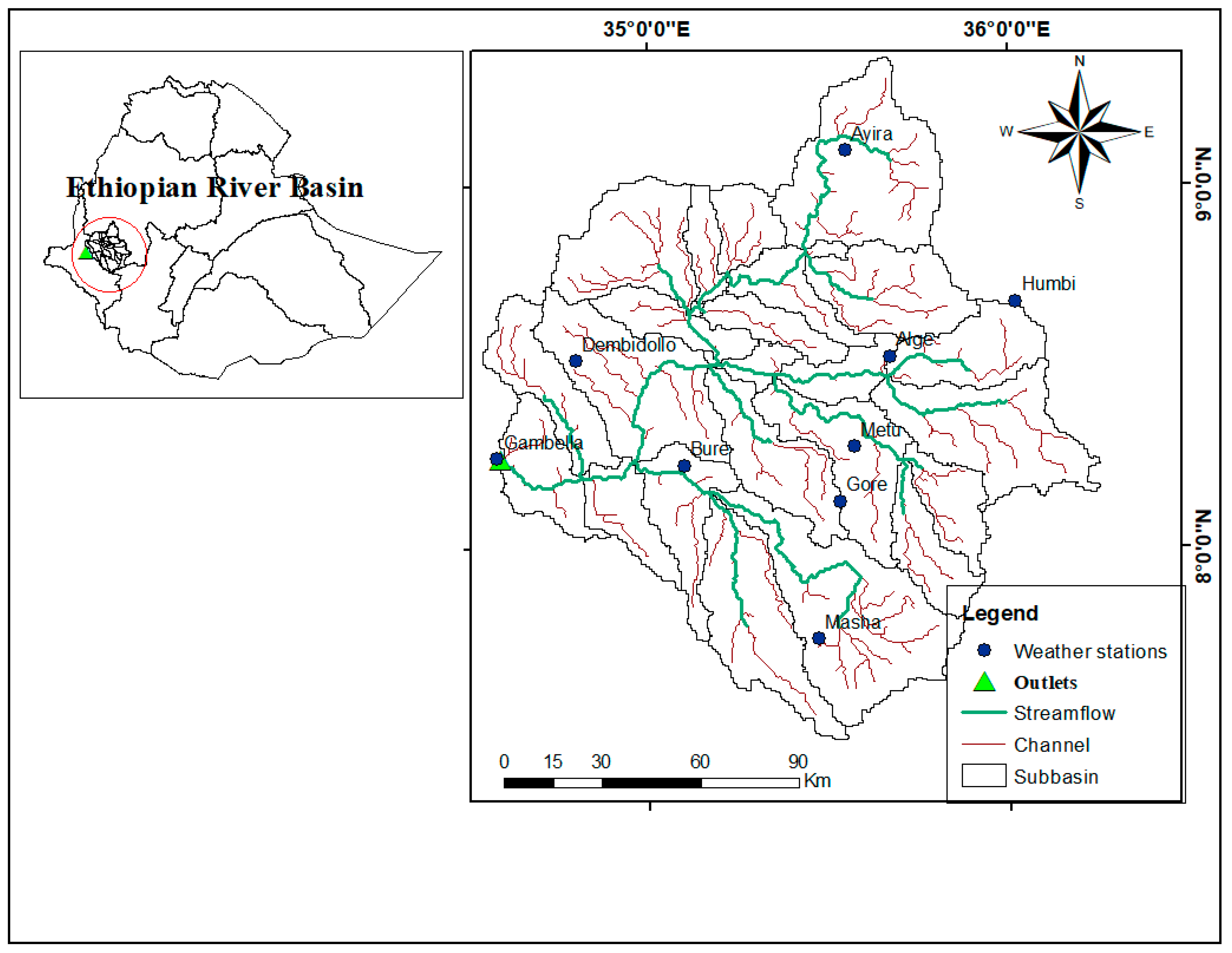
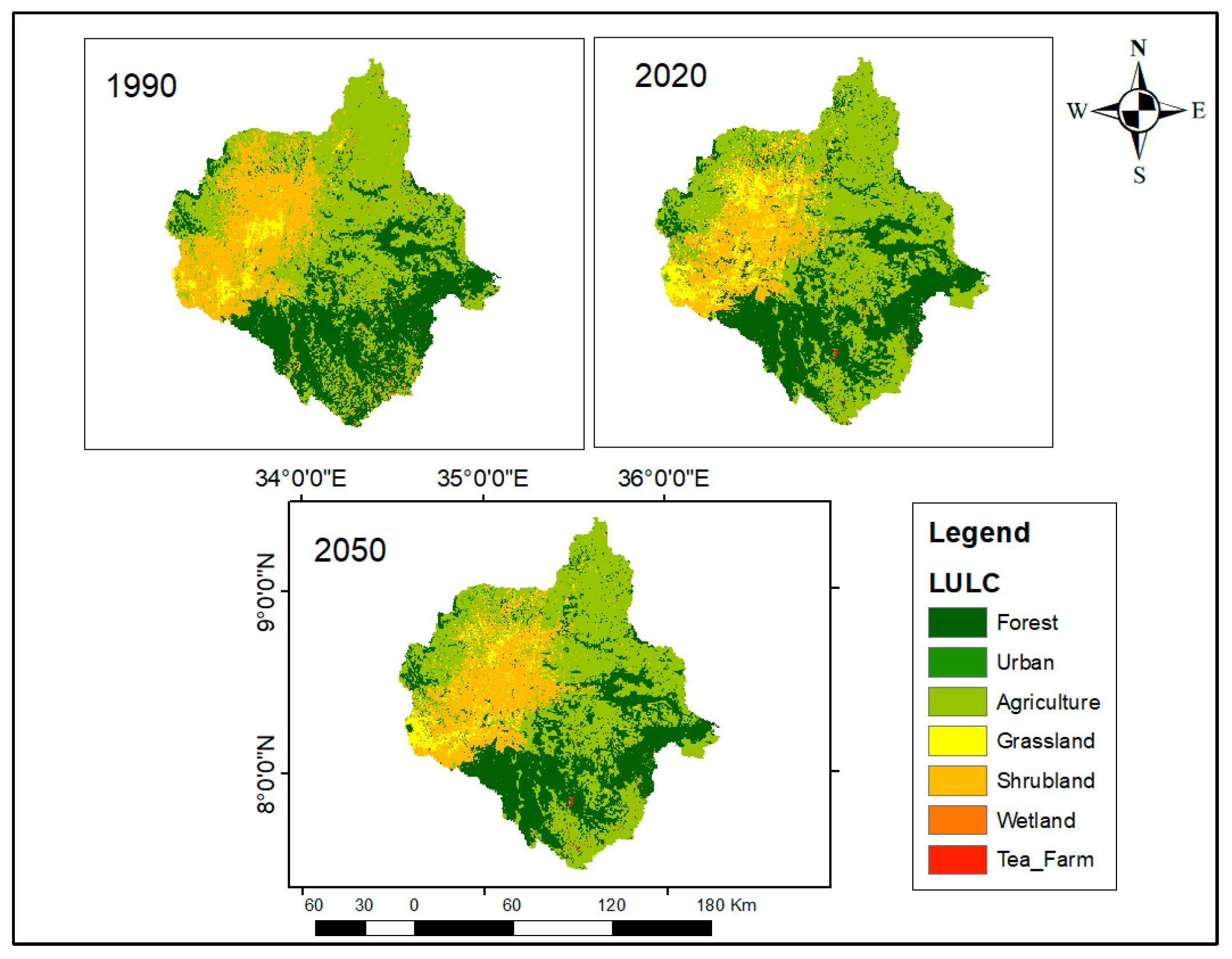


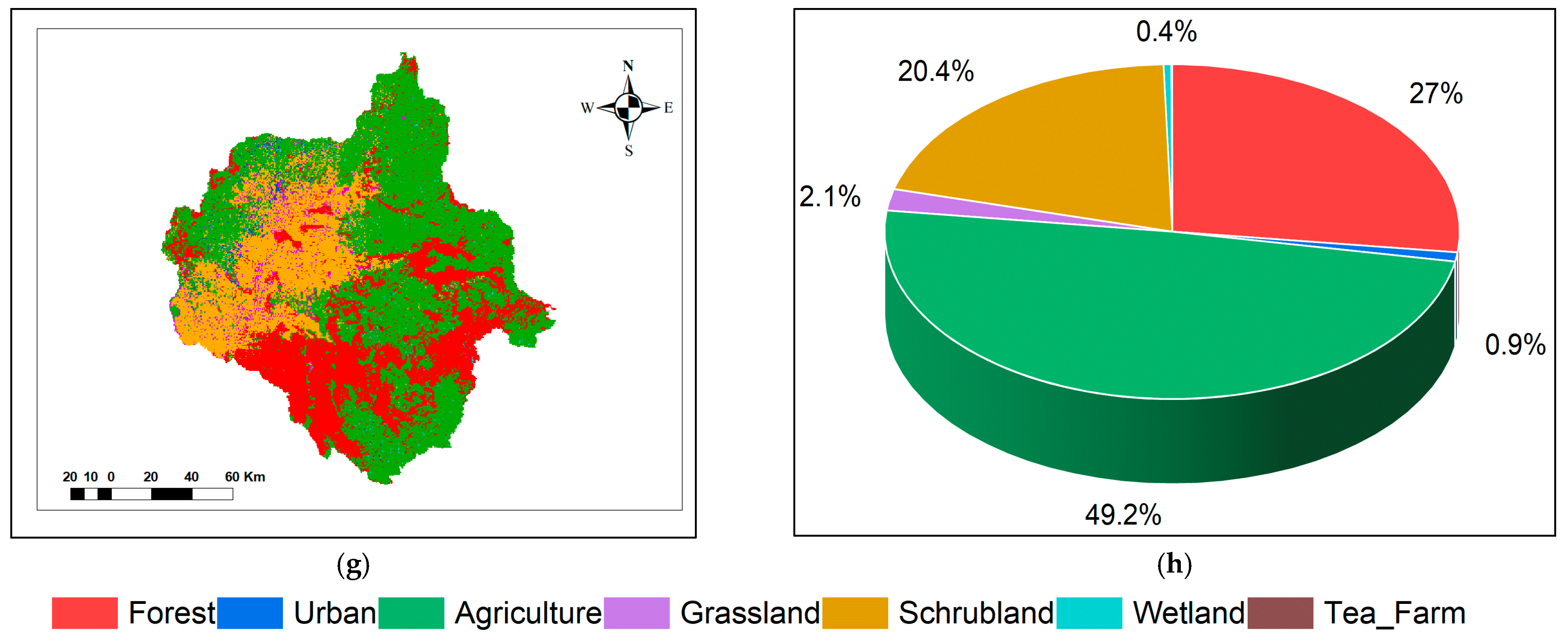
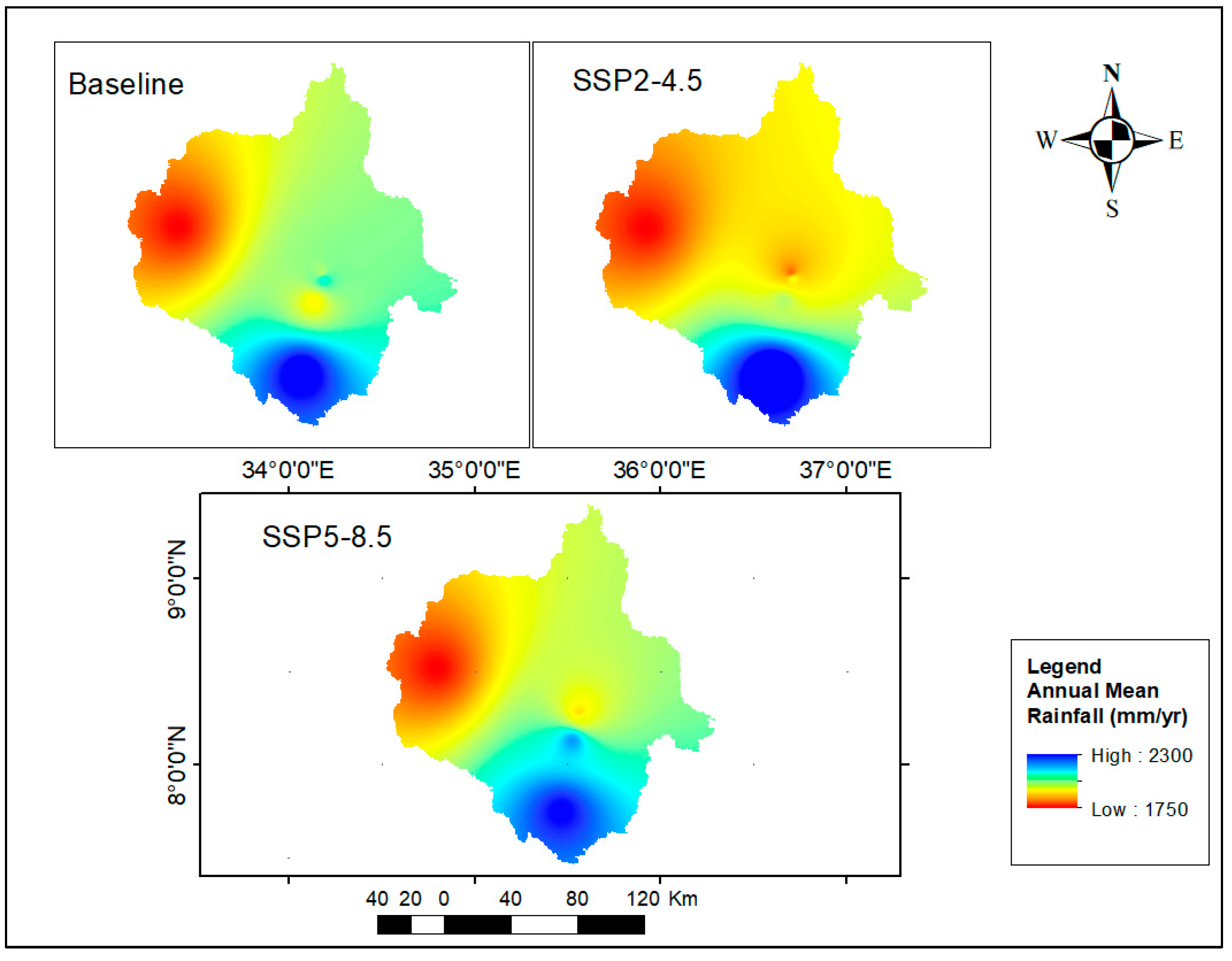

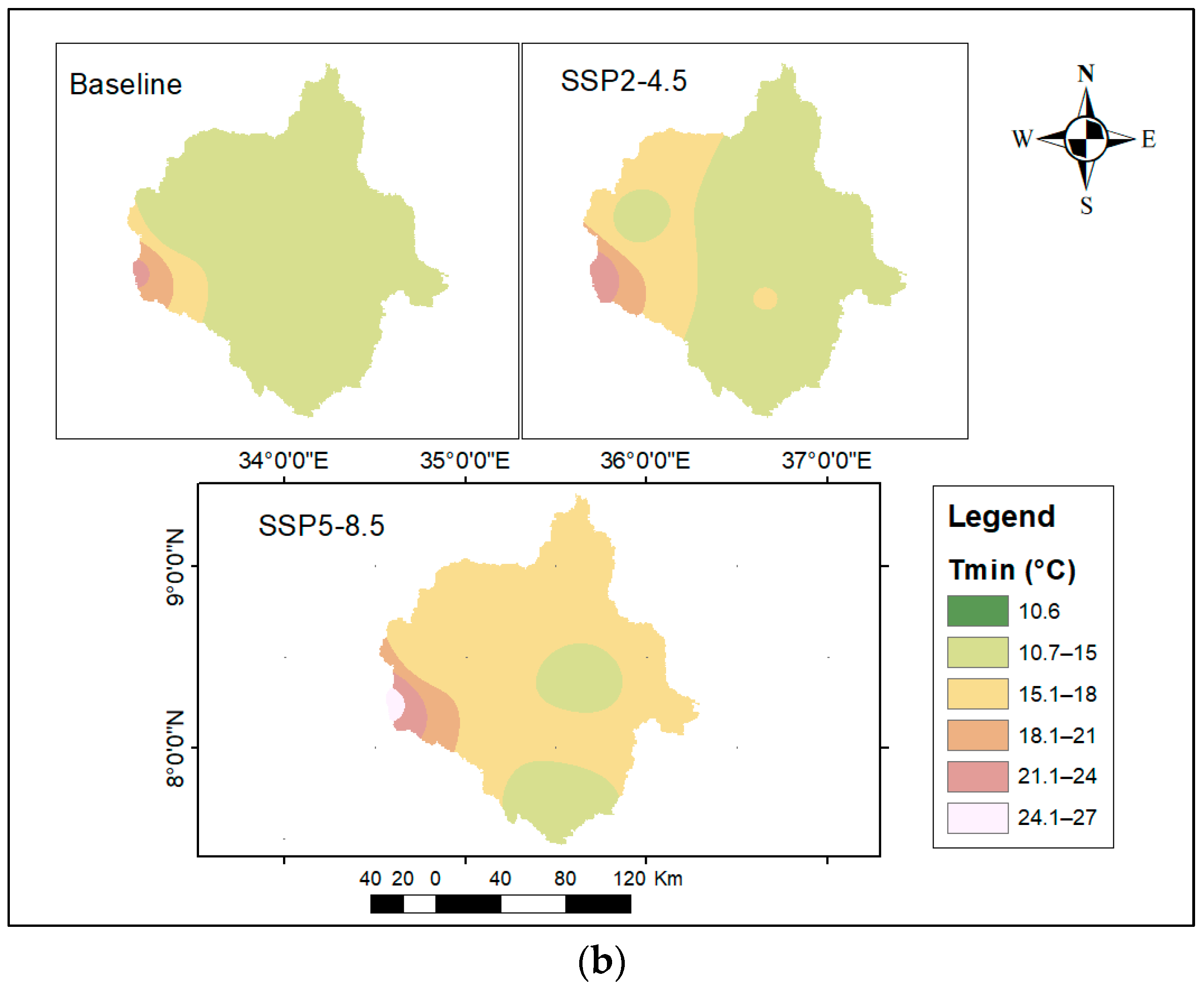
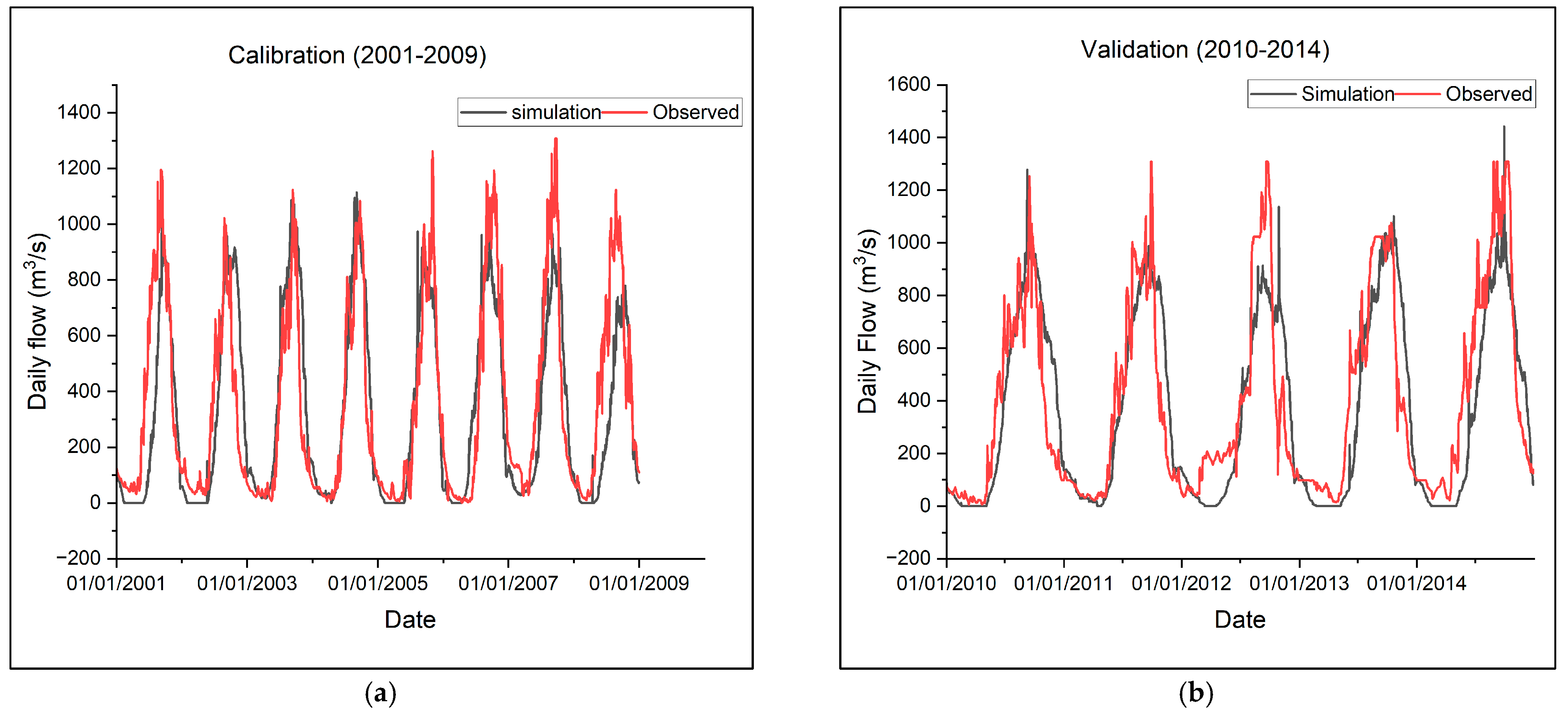

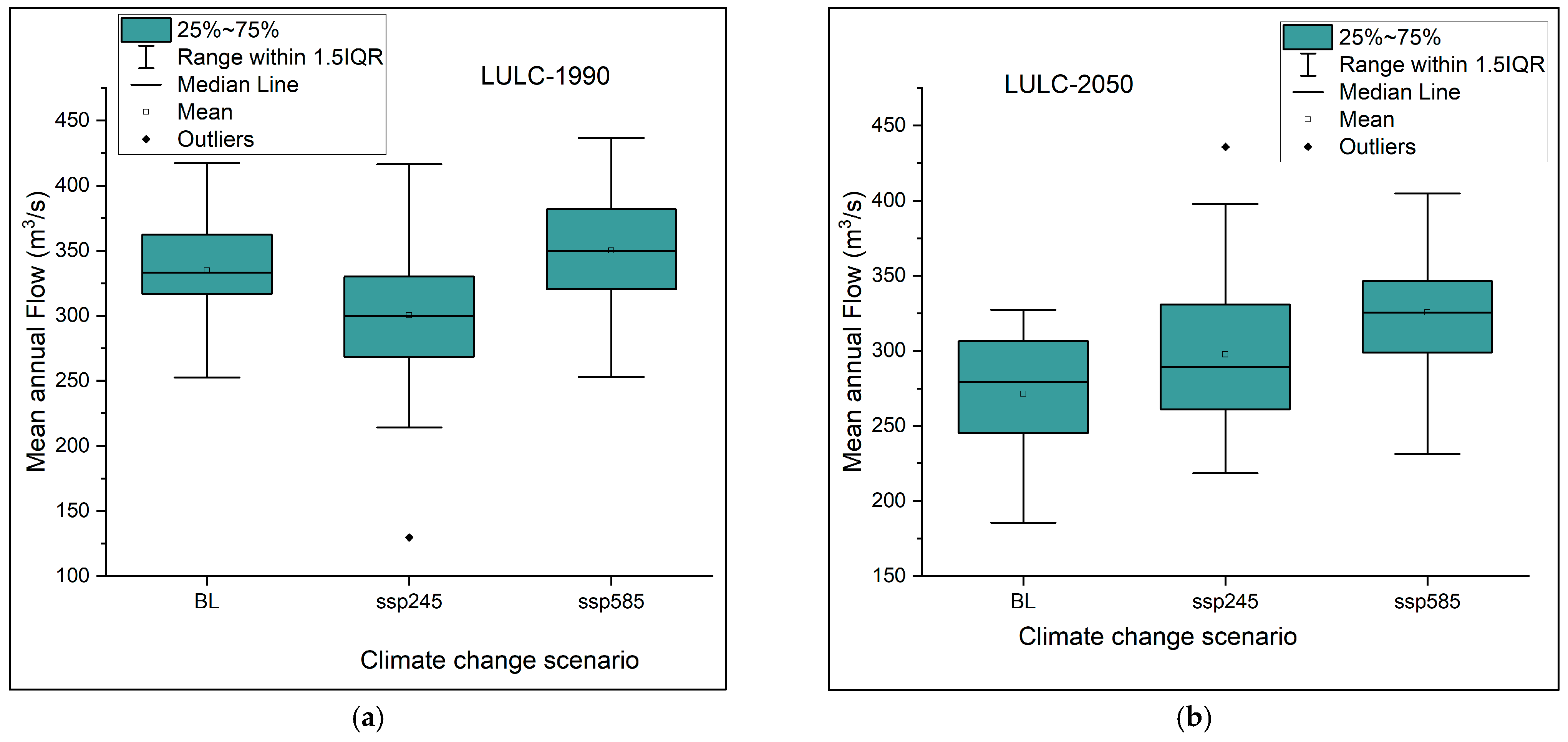
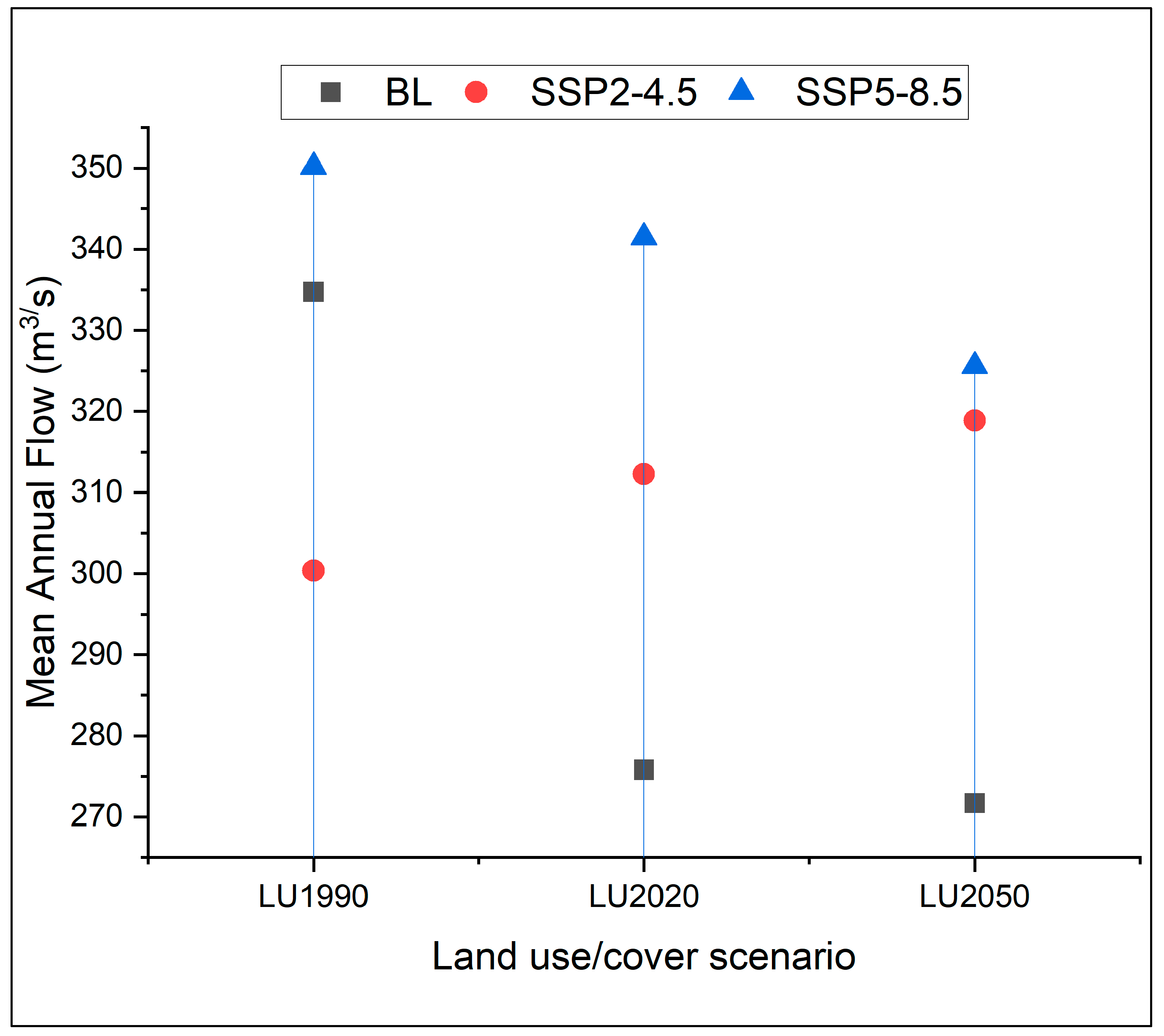


| Parameter | Description | Range | Best Value |
|---|---|---|---|
| CN2 | SCS runoff curve number II | 28–98 | 69.17 |
| ESCO | Soil evaporation compensation factor | 0.01–1 | 0.585 |
| EPCO | Plant uptake compensation factor | 0–1 | 0.755 |
| PERCO | Amount of water percolating out of root zone (mm H2O) | 0–1 | 0.884 |
| ALPHA | Baseflow alpha factor (days) | 0–1 | 0.644 |
| CHK | Effective hydraulic conductivity in channel (mm/h) | 0.01–500 | 272.9 |
| AWC | Available water content of the soil layer (mm H2O/mm) | 0.01–1 | 0.228 |
| K | Saturated hydraulic conductivity (mm/h) | 0.0001–2000 | 1689.453 |
| LULC | 1990 | 2000 | 2020 | 2050 |
|---|---|---|---|---|
| Forest | 6974 | 6716 | 6152 | 5973 |
| Urban | 54 | 149 | 196 | 196 |
| Agriculture | 9971 | 10,417 | 10,764 | 10,881 |
| Grassland | 448 | 985 | 606 | 458 |
| Shrubland | 4442 | 3772 | 4332 | 4523 |
| Wetland | 247 | 70 | 75 | 96 |
| Tea_Farm | 0 | 31 | 14 | 11 |
| Impact Analysis for Streamflow Variability | Input Simulations |
|---|---|
| Land use effect analysis | Predicted LULC of 2020 and 2050 with baseline climate data of 1985–2014 |
| Climate change effect analysis | Projected climate for 2041–2070 with baseline LULC data of 1990 under SSP2-4.5 and SSP5-8.5 scenarios |
| Relative and combined effect of land use and climate change on streamflow | Projected climate for 2041–2070 with LULC of 2050 under both scenarios, SSP2-4.5 and SSP5-8.5 |
| Modeled Scenarios | LULC-1990 | LULC-2020s | LULC-2050 |
|---|---|---|---|
| Baseline climate | Climate 1985–2014 and LULC-1990 | Climate 1985–2014 and LULC-2020 | Climate 1985–2014 and LULC-2050 |
| 2050s Climate | Climate (2041–2070) and LULC-1990 | Climate 2041–2070 and LULC-2020 | Climate 2041–2070 and LULC-2050 |
| Period/Evaluation Criteria | NSE | PBIAS | RMSE | R2 |
|---|---|---|---|---|
| Calibration (2001–2009) | 0.68 | 0.03 | 0.6 | 0.7 |
| Validation (2010–2014) | 0.73 | 0.01 | 0.17 | 0.74 |
| Scenario | LU1990 | LU2020 | LU2050 | Description |
|---|---|---|---|---|
| Baseline climate (1985–2014) | 334.8 | 275.8 | 271.7 | LULC effect analysis |
| SSP2-4.5 climate (2041–2070) | 300.4 | 312.3 | 318.9 | Combined effect |
| SSP5-8.5 climate (2041–2070) | 350.2 | 341.5 | 325.6 | |
| Description | Climate change effect analysis | Combined effect | ||
Disclaimer/Publisher’s Note: The statements, opinions and data contained in all publications are solely those of the individual author(s) and contributor(s) and not of MDPI and/or the editor(s). MDPI and/or the editor(s) disclaim responsibility for any injury to people or property resulting from any ideas, methods, instructions or products referred to in the content. |
© 2024 by the authors. Licensee MDPI, Basel, Switzerland. This article is an open access article distributed under the terms and conditions of the Creative Commons Attribution (CC BY) license (https://creativecommons.org/licenses/by/4.0/).
Share and Cite
Kassaye, S.M.; Tadesse, T.; Tegegne, G.; Hordofa, A.T.; Malede, D.A. Relative and Combined Impacts of Climate and Land Use/Cover Change for the Streamflow Variability in the Baro River Basin (BRB). Earth 2024, 5, 149-168. https://doi.org/10.3390/earth5020008
Kassaye SM, Tadesse T, Tegegne G, Hordofa AT, Malede DA. Relative and Combined Impacts of Climate and Land Use/Cover Change for the Streamflow Variability in the Baro River Basin (BRB). Earth. 2024; 5(2):149-168. https://doi.org/10.3390/earth5020008
Chicago/Turabian StyleKassaye, Shimelash Molla, Tsegaye Tadesse, Getachew Tegegne, Aster Tesfaye Hordofa, and Demelash Ademe Malede. 2024. "Relative and Combined Impacts of Climate and Land Use/Cover Change for the Streamflow Variability in the Baro River Basin (BRB)" Earth 5, no. 2: 149-168. https://doi.org/10.3390/earth5020008









